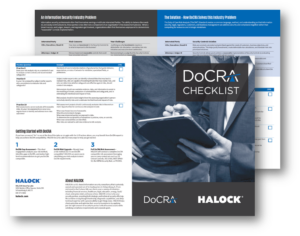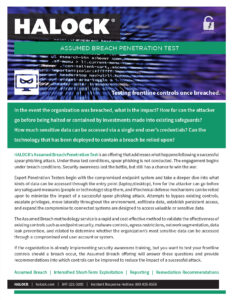Assumed Breach Penetration Testing

What is an Assumed Breach Penetration Test?
HALOCK’s Assumed Breach Penetration Test addresses what happens following a successful spear phishing attack. Expert penetration testers begin this engagement under breach conditions using a compromised endpoint system, and taking a deep dive into what kinds of data can be accessed through the entry point (laptop/desktop), how far the attacker can go before any safeguard measures (people or technology) stop them, and if technical defense mechanisms can be relied upon to minimize the impact of a successful spear phishing attack.
![]()
Why Choose HALOCK? How does the Assumed Breach Penetration Test benefit an organization?
How far can the attacker go before being halted or contained by investments made into existing safeguards? How much sensitive data can be accessed via a single end user’s credentials? Can the technology that has been deployed to contain a breach be relied upon?
All of these questions are addressed during HALOCK’s Assumed Breach Penetration Test. HALOCK’s penetration testers will attempt to bypass existing controls, escalate privileges, move laterally through the environment, exfiltrate data, establish persistent access, and expand the compromise to connected systems – all in attempt to access valuable or sensitive data.
This penetration test offering is a rapid and cost-effective method to validate the effectiveness of existing controls such as endpoint security, malware controls, egress restrictions, network segmentation, and data leak prevention. With this test, HALOCK can help determine whether the organization’s most sensitive data can be accessed through a compromised end user account or system.
HALOCK has the experience to best assess how well an organization’s security awareness policies and procedures are performed. For over two decades, HALOCK has conducted thousands of successful Assumed Breach pen tests for companies of all sizes, across all industries.
HALOCK’s dedicated penetration test team is highly qualified, possesses advanced certifications, and is equipped with the labs, tools, and methodologies necessary to consistently deliver quality, accurate, detailed, and meaningful results.
A Comprehensive Methodology for Assumed Breach Penetration Test
- Information Gathering Initial reconnaissance activities to gather the necessary information to prepare suitable and credible messaging, such as the services the target organization offers, relationships between varying business units or divisions, information exposed on public sources, and other employee or corporate specific information.
- Infrastructure Preparation Systems to transport email, track responses and activity, and host content are deployed and configured.
- Campaign Preparation Target lists are grouped and sequenced, campaign batches are configured and scheduled, and related preparation tasks are completed.
- Campaign Launch Initial test messages are issued to gauge response behavior, identify technical controls that might warrant revising the planned approach, and fine-tuning attack methods.
- Initial Exploits As sessions are established, initial exploits are pursued to establish baseline access through payloads, command and control, scripted actions, identify secondary targets on the compromised network, and establish persistence.
- Secondary Exploits attempts to increase a presence throughout the connected environment by bypassing user access controls, identifying internal weaknesses to exploit, leveraging excessive user rights, and compromising connected systems.
- Exfiltration Attempts to identify local data repositories that would be of value to an attacker stored on locations such as local repositories, mapped drives, databases, and file sync folders.
- Disengaging Winding down activities including terminating sessions, gathering evidence necessary for reporting, and preventing continued contact following the conclusion of the campaign.

– Investment Firm
Deliverables
- Project Plan: Prior to remote assumed breach penetration testing, HALOCK will develop a project plan detailing the specific plan, timing, and related considerations. This ensures all parties know what to expect throughout the execution of testing and reporting.
Penetration Test Report
The complete results of the assumed breach pen test are documented in our content rich report which includes the background, summary of findings, detailed findings, scope and methodology, and supplemental content for context and reference.
- Background: An introduction of the general purpose, scope, methodology, and timing of the assumed breach penetration test.
- Summary of Findings: A concise overview summarizing the assumed breach results at a glance, such as key critical findings requiring priority attention, system or recurring issues, and other general results.
- Detailed Findings: Comprehensive results of each vulnerability, including a description of the vulnerability observed, the impact, recommendations for remediation, evidence where the vulnerability was observed, step-by-step demonstrations of exploits performed, and additional reference materials.
- Scope and Methodology: A detailed recap of the specific scope of what was tested, the methodologies utilized, and related historical information necessary for audiences such as auditors to understand the specifics of the test approach.
- Supplemental Content: Additional content and guidance, such as recommended post assumed breach assessment activities.
KEEPING YOU INFORMED – HALOCK SECURITY BRIEFING FOR CLIENTS
The HALOCK Security Briefing is a review of significant events, trends, and movements that will influence how you manage cybersecurity, risk, and compliance. Our clients receive periodic overviews with an extensive report file on the topics discussed. This insightful document also includes reference links throughout the report for easy navigation and deeper research.
HALOCK, a trusted penetration testing company headquartered in Schaumburg, IL, near Chicago, advises clients on reasonable security strategies, risk management, and compliance throughout the US.


